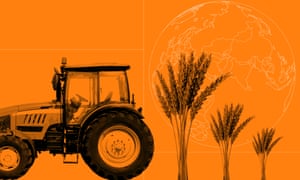
Why do we need to grow more food?
Food production around the world must rise by half in the next 30 years to sustain a global population expected to top 10 billion by 2050.
Compared with 2010, an extra 7,400tn calories will be needed a year in 2050. If food production increases along current lines, that would require a landmass twice the area of India.
These are the findings of a report published in December by the World Resources Institute on the “food gap” between current production and growing consumption.
So we need to find more land to cultivate then?
Bringing more land under agricultural production is one answer to filling this gap, but it cannot solve the problem alone. Finding that amount of land in suitable conditions would spell the end for many of the earth’s remaining forests, peatlands and wild areas, and release the carbon stored in them, hastening climate change.
Intensive farming has already had a huge effect on biodiversity and the environment worldwide. Pesticides, which have helped boost cereal and fruit production, have also killed bees and myriad species of insects in large numbers.
Fertilisers that have improved poor soils have also had unintended harmful consequences. The largest ever maritime “dead zone” was discovered in the Gulf of Mexico last year, the result of fertiliser and manure from the meat industry running off the land. Chemical fertilisers also contribute directly to climate change, through the greenhouse gas nitrous oxide, and to air pollution through ammonia.
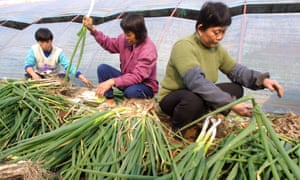
So what are the other answers?
The UN’s Food and Agriculture Organisation, the world’s leading body charged with care of our future food supply, has called this year for “transformative change in our food systems”.
The most obvious alternative to industrialised intensive farming in the developed world is organic farming. The label organic, or bio, is a familiar one in many supermarkets, but makes up only 2% of food sales in the UK and about 5.5% in the US.
Organic farmers must adhere to strict rules on how they grow their crops and raise their livestock. These include using antibiotics on animals only when necessary, cutting out chemical fertilisers and pesticides almost completely in favour of natural alternatives such as manure and wood ash as fertilisers and plant-derived pesticides, and managing land to provide habitats for wildlife.
Rob Percival, head of policy at the Soil Association, says organic farming can feed the world, if consumption patterns are adjusted to encourage those who can afford meat to eat less of it. “We need an urgent shift in both production and consumption if we’re to avert the worst consequences of climate change, including a dietary shift towards less and better meat,” he says.
“Livestock grazing on pasture can support soil health and carbon sequestration, and manure can provide soil fertility for other crops.”
He adds that the productivity of organic farming is greater than previously thought, “and when the environmental and other damage caused by high energy and chemical inputs in non-organic farming are factored in, organic food is cheaper for society and better for the planet”.
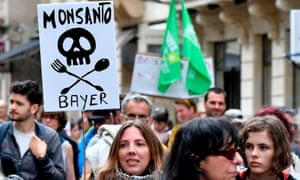
But isn’t organic a burden for farmers?
For many farmers, the investment and time needed to meet organic standards may be a stretch, but there are ways to move towards more sustainable farming without organic certification.
Agroecology is the name given to a broad range of farming techniques that seek to minimise the environmental impact of farming. It encompasses organic farming, but is informal and does not require certification and inspection.
“It is about using natural systems,” says Vicki Hird, food and farming campaigner at Sustain, an NGO. “Reducing the use of artificial chemicals, such as fertilisers and pesticides is an important part of it. Looking closely at the soil and other conditions, nourishing the soil, taking account of the natural pest cycles, natural predators and crop cycles.”
She argues that agroecology could be widely adopted as an alternative to damaging industrialised farming. Farmers can sow crops such as clover as cover to suppress weeds and return organic matter to the soil, and rotate crops, including vegetables such as legumes that fix nitrogen. It requires close attention to the land itself and the crops, rather than the standard mode of farming which is to plant cash crops at the highest yield possible.
“Diversity is the key,” says Hird. “Having these huge monocultures does not lend itself to being managed in a natural way, and can damage biodiversity.”
Diversifying into heritage crops, such as older varieties of fruit and vegetables and a wider variety of grains than the current few strains of wheat that are the norm in intensive agriculture, can also yield benefits. These crops have their own advantages, including natural resistance to certain diseases, pests or conditions.
“You might get a lower yield [by these methods],” Hird concedes, “but you get a higher level of nutrients in the food produced.”
What about permaculture?
Some farmers go further, and embrace concepts such as permaculture and biodynamics. The principles of permaculture involve understanding the relationships between plants and using them in combinations, while reusing any waste products, often as fertiliser.
Biodynamics takes a different approach, following the precepts of Rudolf Steiner and incorporating a spiritual aspect, for instance in some cases aligning planting and harvesting to lunar calendars.
Peatlands, which around the world have been grossly degraded, can also be managed organically through paludiculture. This requires re-wetting dried-out peatlands and looking to alternative plants that grow well there, including forestry and medicinal plants such as sphagnum moss, and allowing animals to graze.
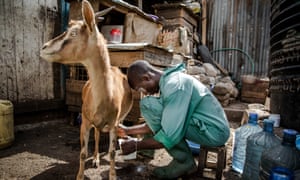
And urban farming?
Urban farming can deliver food – or at least some fresh produce – efficiently to dense populations without the greenhouse gas emissions and nutrient loss associated with transporting it across long distances. Already, urban farming produces about a fifth of the world’s food.
There are currently more than 3,000 urban farming schemes in London alone. These carry an echo of the “market gardens” and dairies of the Victorian era, when small vegetable farms were sited in or near towns and cows were kept in green places in cities for fresh milk.
The cows of Hyde Park, dispensing fresh milk to Londoners, were a familiar sight until the first world war; in the near future, look out for hipsters drinking smoothies from the underground farms of Shoreditch.
These sound a bit niche. Don’t industrial farms produce most of the world’s food?
No. There are more than 570m farms worldwide; more than 90% are run by an individual or family and rely primarily on family labour. They produce about 80% of the world’s food.
Small farmers will be key to the transition, says Ronald Vargas, soil and land officer at the FAO. Many small farmers are poor and insecure, but FAO considers investment in smallholder production “the most urgent and secure and promising means of combating hunger and malnutrition, while minimising the ecological impact of agriculture”.
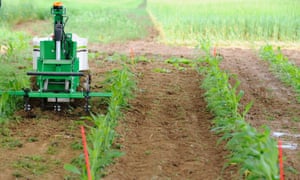
How can technology and innovation help?
There is no shortage of innovation and tech to help improve efficiencies and yields – on industrial farms and smallholdings. GPS, drones and fine-grained data on topography, soils and other aspects of farmland to allow farmers to target specific areas with fertilisers, pesticides and water, instead of blanket spraying.
For instance, Olam, a global agribusiness that produces cocoa, coffee, sugar, cotton and other crops, uses real-time monitoring on its plantations to finely judge fertiliser quantities and avoid the need for the pre-emptive use of pesticides. Its almond trees in Australia are fitted with sensors to monitor exactly how much water each tree needs, and when.
For family farmers in the developing world, mobile phones are revolutionising what is possible. They have given farmers in remote areas access to tools such as weather forecasts, market prices, yield information and practical advice. GPS is also allowing them to track their produce after it leaves the farm.
Drones and robots may seem futuristic but are already in use, delivering targeted pesticides and picking out damaged or diseased crops before they can infect others around them.
In parts of the world where space is at a premium, vertical farming is catching on. This refers to the practice of stacking crops, usually vegetables, in shallow containers in layers, which can reach any height available. It not only saves on space, but can also be managed to use water and energy more efficiently, as water can be pumped to the top and allowed to flow down by gravity.
Some systems use hydroponics, by which the plants are immersed in water containing mineral solutions, in place of soil. Temperatures can be carefully controlled, water reused, and nutrients recycled. Software systems can control the delivery mechanisms and monitor how the plants are faring.
Our new-found abilities to control light, temperature, air and other environmental factors open up new vistas for farming. Underground growing used to be reserved for mushrooms and niche crops such as forced rhubarb, grown in large warehouses.
If LEDs can take the place of sunlight, a far greater variety of plants can thrive in these conditions, making not only rooftops but basements and disused underground spaces from worked-out mines to old railway lines potentially viable venues for growing short-cycle foodstuffs.
What next?
Our reliance on artificial fertiliser and intensive farming techniques did not happen overnight, but took decades. Along the way, these methods revolutionised farming and enabled huge population growth and economic growth. We now have a wealth of scientific evidence that shows that continuing down the same path would risk runaway climate change, the extinction of species vital to human life, pollution of our water and air, and the death of our soils.
“Industrial agriculture exploits the available natural resources of our planet to an untenable and unsustainable extent,” says Vargas of the FAO. “The basic strategy to replace human labour with farm machinery, agrochemicals and fossil energy is a dead end in times of climate change, dwindling oil reserves and over-exploited natural resources.”
Experts say a second revolution is now needed, that will encompass not just our growing methods but consumption habits and our entire food economy. This would have to involve farmers, retailers, governments and consumers. In last century’s farming revolution, only one future was offered: industrialisation. For this century, there will be a plurality of alternatives, and combinations of new and ancient technology, and all have their place.
“There is not one huge conceptual change where you do everything differently and everything will be OK,” says Tim Searchinger of Princeton University and the World Resources Institute. “There is not one single answer. There are lots and lots of things we can and need to do.”
[“source=theguardian”]



